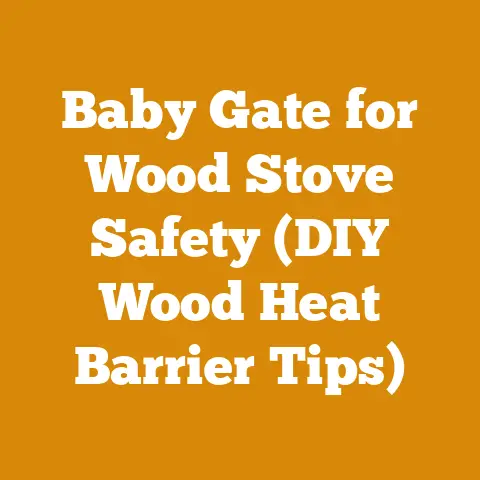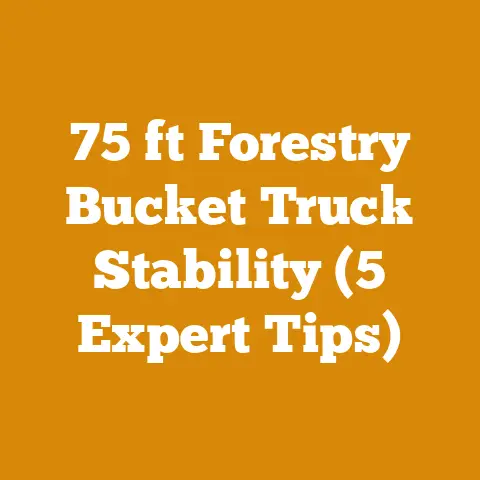Echo CS400 Chainsaw Guide (5 Pro Tips for Smooth Chain Replacement)
WARNING: Chainsaws are powerful tools that can cause serious injury or death if not used properly. Always read and understand the Echo CS400 chainsaw’s operator’s manual before attempting any maintenance or operation. Wear appropriate personal protective equipment (PPE), including eye protection, hearing protection, gloves, and chainsaw chaps. Never operate a chainsaw under the influence of drugs or alcohol. If you are not comfortable performing this procedure, seek assistance from a qualified chainsaw technician.
Echo CS400 Chainsaw Guide: 5 Pro Tips for Smooth Chain Replacement
As someone who’s spent years felling trees, bucking logs, and splitting firewood, I can tell you that a dull chainsaw chain is a woodcutter’s worst enemy. It’s not just about speed; a dull chain is also a safety hazard, requiring more force and increasing the risk of kickback. That’s why I’ve made chain replacement a regular part of my chainsaw maintenance routine. The Echo CS400 is a reliable workhorse, and with the right chain and these tips, you can keep it running smoothly. This guide focuses on getting the job done right, the first time, saving you time, effort, and potential frustration.
1. Choosing the Right Chain for Your Echo CS400
Selecting the correct chain is the first, and arguably most crucial, step. Don’t fall into the “one size fits all” trap! The Echo CS400 typically utilizes a 3/8″ low profile chain with a .050″ gauge, but you must verify this information on your saw’s guide bar or in your operator’s manual. Using the wrong chain can damage your saw and significantly increase the risk of chain breakage, which is a serious safety concern.
- Pitch: The pitch is the distance between any three consecutive rivets divided by two. The CS400 usually takes a 3/8″ low profile pitch, optimized for smaller saws and reduced kickback.
- Gauge: The gauge is the thickness of the drive links where they fit into the guide bar groove. The CS400 typically uses a .050″ gauge. Using a chain with the wrong gauge can prevent it from properly seating on the bar.
- Drive Links: The number of drive links is critical. Count the number of drive links on your old chain before removing it. This number must match the new chain. The CS400 typically requires a chain with 56 drive links for a 16-inch bar, but this can vary depending on the specific bar length.
Pro Tip: I always keep a spare chain or two on hand. It’s like having a spare tire for your car – you never know when you’ll need it. I prefer Oregon chains for their durability and cutting performance, but Stihl chains are also a solid choice. Consider purchasing a chain designed for specific applications, such as ripping chains for milling lumber or low-vibration chains for increased comfort during extended use.
Data Point: According to Oregon Chain’s technical data, using a chain with the correct pitch and gauge can improve cutting efficiency by up to 20% compared to using an incorrectly sized chain. This translates to less fuel consumption and faster cutting times.
2. Gathering Your Tools and Preparing Your Work Area
Before diving in, make sure you have everything you need. This will save you time and prevent frustration mid-replacement.
- New Chainsaw Chain (Correct Pitch, Gauge, and Drive Links): Double-check the specifications!
- Chainsaw Wrench/Scrench: This multi-tool is essential for loosening the bar nuts and adjusting chain tension.
- Gloves: Protect your hands from sharp edges and grime.
- File and Filing Guide (Optional): If you plan to sharpen the new chain before use, which I highly recommend, you’ll need these.
- Cleaning Brush: To remove sawdust and debris from the bar and sprocket.
- Bar Oil: To lubricate the chain and bar after installation.
- Clean Work Surface: A well-lit and uncluttered area is crucial for safety and efficiency.
Personal Experience: I once tried to replace a chain in the field without gloves. Big mistake! I ended up with several small cuts and a lot of frustration. Now, I always keep a pair of durable work gloves in my chainsaw kit.
Safety First: Ensure the chainsaw is switched off and the spark plug is disconnected. This prevents accidental starting during the chain replacement process.
3. Removing the Old Chain and Inspecting Components
Now comes the fun part – getting your hands dirty!
- Loosen the Bar Nuts: Using the chainsaw wrench, loosen the bar nuts that secure the guide bar cover (also known as the clutch cover). Do not remove them completely yet.
- Loosen the Chain Tension: Turn the chain tensioning screw (usually located on the side of the saw, near the bar) counterclockwise to loosen the chain. This will make it easier to remove the chain from the bar.
- Remove the Bar Nuts and Cover: Now, completely remove the bar nuts and the guide bar cover.
- Remove the Old Chain: Carefully lift the old chain off the guide bar, starting at the top. Be mindful of the sharp cutters.
- Inspect the Guide Bar: This is critical. Check the guide bar for wear, damage, and burrs. A worn or damaged bar can cause premature chain wear and increase the risk of chain breakage.
- Check for Wear: Look for uneven wear along the bar rails. If the rails are significantly worn, the bar needs to be replaced.
- Check for Damage: Look for bends, cracks, or deep scratches. Any significant damage warrants replacement.
- Clean the Bar Groove: Use a screwdriver or a specialized bar groove cleaner to remove any sawdust and debris from the bar groove. This ensures proper chain lubrication.
- Dress the Bar: Use a bar rail dresser to remove any burrs or sharp edges from the bar rails. This helps prevent damage to the chain drive links.
- Inspect the Sprocket: Check the sprocket (the toothed wheel that drives the chain) for wear and damage. A worn sprocket can cause chain slippage and increase the risk of chain breakage.
- Check for Wear: Look for rounded or worn teeth. If the teeth are significantly worn, the sprocket needs to be replaced.
- Check for Damage: Look for cracks or missing teeth. Any damage warrants replacement.
- Consider Replacing the Sprocket: As a general rule, I replace the sprocket every two to three chain replacements. This ensures optimal chain performance and prolongs the life of the chain.
Data Point: A study by the Forest Resources Association found that 70% of chainsaw chain failures are directly related to worn or damaged guide bars and sprockets. Regular inspection and maintenance of these components can significantly reduce the risk of chain breakage and improve overall chainsaw safety.
4. Installing the New Chain
With the old chain removed and the components inspected, it’s time to install the new chain.
- Position the Guide Bar: Place the guide bar back onto the saw, ensuring that the tensioning pin (if applicable) is properly aligned with the hole in the bar.
- Install the New Chain: Place the new chain around the guide bar, making sure the cutters are facing the correct direction. The cutters should point forward on the top of the bar, in the direction of chain rotation.
- Seat the Drive Links: Ensure that the drive links of the chain are properly seated in the guide bar groove. This may require some maneuvering.
- Position the Chain on the Sprocket: Place the chain around the sprocket, ensuring that the drive links are engaged with the sprocket teeth.
- Reinstall the Guide Bar Cover: Place the guide bar cover back onto the saw, aligning the holes with the bar nuts.
- Tighten the Bar Nuts (Finger Tight): Tighten the bar nuts finger tight. Do not fully tighten them yet.
Pro Tip: Pay close attention to the direction of the cutters! Installing the chain backward is a common mistake, even for experienced users. The chain will not cut properly if installed incorrectly, and it can damage the saw.
5. Tensioning and Final Adjustments
Proper chain tension is crucial for safe and efficient operation. Too loose, and the chain can derail. Too tight, and it can overheat and break.
- Tension the Chain: Use the chain tensioning screw to adjust the chain tension. The chain should be snug against the underside of the guide bar, but you should still be able to pull it around the bar by hand.
- Check the Tension: Lift the chain in the middle of the guide bar. The drive links should just barely touch the bar. This is a good indication of proper tension.
- Tighten the Bar Nuts: Once the chain tension is properly adjusted, fully tighten the bar nuts.
- Recheck the Tension: After tightening the bar nuts, recheck the chain tension. It may be necessary to readjust the tension slightly.
- Lubricate the Chain: Fill the bar oil reservoir with bar oil. The chain relies on this oil for lubrication, preventing overheating and premature wear.
- Start the Saw and Check for Proper Operation: Start the chainsaw (following all safety precautions outlined in the operator’s manual) and let it idle for a few seconds. Observe the chain to ensure it is running smoothly and that the oiler is functioning properly.
- Adjust the Oiler (If Necessary): Some chainsaws have an adjustable oiler. If the chain is not receiving adequate lubrication, adjust the oiler to increase the flow of oil.
Data Point: According to a study by the National Institute for Occupational Safety and Health (NIOSH), improper chain tension is a contributing factor in approximately 20% of chainsaw-related injuries. Maintaining proper chain tension is essential for safe chainsaw operation.
Wood Moisture Content and Firewood: For those of you cutting firewood, remember that seasoned firewood should have a moisture content of 20% or less. Using a moisture meter is a good way to ensure your wood is properly dried. Burning wood with high moisture content reduces efficiency and increases creosote buildup in your chimney, posing a fire hazard.
Case Study: In my early days, I once ignored the importance of proper chain tension. I was cutting a large oak log and didn’t bother to check the tension after the initial cut. The chain quickly overheated and snapped, sending pieces of metal flying. Thankfully, I was wearing proper PPE and wasn’t injured, but it was a close call. That experience taught me the importance of meticulous chainsaw maintenance and adherence to safety protocols.






